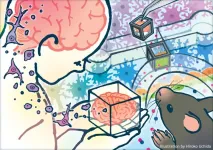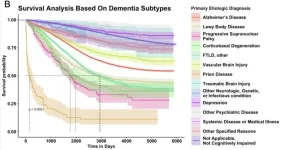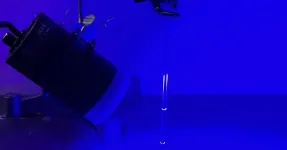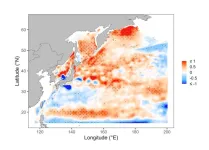(Press-News.org) Young people could be spared from going blind by a new genetic risk tool that could also help diagnose multiple sclerosis (MS) earlier, to start effective treatments.
Optic neuritis is a condition that affects people of all ages, but especially young adults, usually manifesting in blurred vision and sometimes pain when moving the eyes. Up to half of people affected in the UK eventually go on to develop MS – often many years later. Emerging evidence indicates that starting the very effective MS treatments earlier may improve long term health.
Optic neuritis occurs because of swelling in or around the optic nerve. For those with MS-related optic neuritis, the swelling subsides on its own, and vision usually recovers. For many people whose optic neuritis does not result from MS, the optic nerve can be permanently damaged unless high doses of steroids are given quickly, resulting in loss of sight. However, steroids can result in harmful side effects. When people first develop optic neuritis, it can be difficult for patients and their doctors to decide whether the possible benefits of steroid outweigh the possible harms, when the likely cause of the optic neuritis is unclear.
Identifying whether there is an underlying cause of optic neuritis can be challenging for clinicians, with many important test results taking weeks to return. Now, new research, published in Nature Communications and led by the University of Exeter and King’s College London, has shown for the first time that combining genetic risk for MS with demographic factors significantly improves MS risk prediction in people presenting with optic neuritis.
Co-author Dr Tasanee Braithwaite, consultant ophthalmologist to the Medical Eye Unit at Guy’s and St Thomas NHS Foundation Trust, and Adjunct Senior Lecturer at King’s College London said: “As a doctor caring for many patients with optic neuritis, I’m excited by the possibility of translating this pilot research into front line clinical care in the near future. Whilst more research is needed, our study provides a strong signal that we could better identify patients at high risk of MS, perhaps enabling these people to have earlier MS treatment in the future. Whereas, if we could better identify people whose optic neuritis is very unlikely to result from MS, we could treat these people urgently to reduce irreversible vision loss and blindness."
The team analysed more than 300 common genetic variants linked to developing MS, combining them into a genetic risk score that helps clinicians understand an individual’s chance of developing MS. They analysed data from 500,000 people in the UK Biobank, who have shared genetic samples, questionnaires and linked health information from their electronic medical records.
The researchers found 2,369 people who had MS in the UK Biobank, and 687 people with optic neuritis. Of those, 545 had no identifiable cause for their optic neuritis at the start of the study, and 124 went on to develop MS.
Applying the genetic risk score effectively helped separate those at lowest risk from those at high risk. Whilst the MS genetic risk score is not a diagnostic test, this study highlights that it could add one valuable additional piece of information to support doctors and patients to make better decisions.
Co-author Professor Richard Oram, of the University of Exeter Medical School, said: “Since the first genome was sequenced three decades ago, we’ve been working towards the promise of being able to use genetics to improve outcomes for individual patients. This research is an excellent example of precision genetic diagnosis in practice.”
Dr Clare Walton, Head of Research at MS Society, said: “Currently, 130,000 people live with MS in the UK and one in five will have experienced optic neuritis at the start of their MS journey. This research shows how using genetic scores could be a useful way to predict who will likely continue to an MS diagnosis.
“Using immunotherapies in people at high risk of MS could significantly delay the onset of the condition, but these drugs come with side effects. This exciting study opens up the possibility of finding people in which the benefits will outweigh the risks.”
The research stemmed from a summer project led by University of Exeter Medicine student Pavel Loginovic. With funding from the University of Exeter, it expanded into a research collaboration involving academics in Finland and the US. The research was further funded through Fight for Sight and the Royal College of Ophthalmologists, who awarded Dr Braithwaite a Zakarian Award to support this work.
Pavel said: “I’m elated to see this paper published, and it’s gratifying that it could have a real impact in moving research forward, ultimately aiming to get people with MS diagnosed and perhaps treated earlier. Leading this analysis while staying on top of my medical studies has been a challenge and an immense opportunity for growth, professional and personal. I’ve enjoyed the academic journey so far, and I’m excited for what's to come.”
The study is entitled, ‘Applying a genetic risk score model to enhance prediction of future Multiple Sclerosis diagnosis at first presentation with optic neuritis’, and is published in Nature Communications.
END
Understanding genetic risk could save sight and predict multiple sclerosis earlier in young people
New research has shown for the first time that combining genetic risk for MS with demographic factors significantly improves MS risk prediction in people
2024-02-28
ELSE PRESS RELEASES FROM THIS DATE:
Cannabis use linked to increase in heart attack and stroke risk
2024-02-28
Research Highlights:
An analysis of survey data for 430,000 adults in the U.S. found that using cannabis has a significant association with an increased risk of heart attack and stroke, independent of tobacco use, with higher odds among the adults with more frequent use (more days of use per month). The most common method of cannabis use was smoking, followed by eating or vaporizing it.
The increase in the combined risk of coronary heart disease, heart attack and stroke was similar to the risk among the subset of adults who had never used e-cigarettes but did use cannabis.
Embargoed until 4 a.m. CT/5 a.m. ET Wednesday, February ...
Researchers model blood-brain barrier using “Tissue-in-a-CUBE" system
2024-02-28
A research team at the RIKEN Center for Biosystems Dynamics Research (BDR) in Japan has succeeded in establishing a model of the blood-brain barrier using modularized tissue derived from human cells. The “Tissue-in-a-CUBE” is a small cubic structure that could provide a boost in the drug discovery field and be used as an alternative to animal models in pre-clinical studies. The study was published in Communications Biology on February 28.
The blood-brain barrier is a strict gatekeeper around the brain that prevents foreign substances in blood from entering the brain. Although protective, the barrier poses challenges when treatments ...
Study identifies blood biomarkers to predict risk of cardiovascular disease in patients with rheumatoid arthritis
2024-02-28
KEY TAKEAWAYS
Rheumatoid arthritis is associated with increased risk of cardiovascular disease, but it can be challenging to predict which individuals are at highest risk.
Mass General Brigham experts in rheumatology and cardiovascular disease worked together to identify six biomarkers found in blood samples that can predict future risk of arterial inflammation among patients with rheumatoid arthritis.
The team is now working to test these biomarkers in a larger and more long-term cohort of patients with rheumatoid ...
Ai finds key signs that predict patient survival across dementia types
2024-02-28
New York, NY [February 28, 2024]—Researchers at the Icahn School of Medicine at Mount Sinai and others have harnessed the power of machine learning to identify key predictors of mortality in dementia patients.
The study, published in the February 28 online issue of Communications Medicine [10.1038/s43856-024-00437-7], addresses critical challenges in dementia care by pinpointing patients at high risk of near-term death and uncovers the factors that drive this risk. Unlike previous studies that focused on diagnosing dementia, this research delves into predicting patient prognosis, shedding light on mortality ...
Light stimulates a new twist for synthetic chemistry
2024-02-28
Molecules that are induced by light to rotate bulky groups around central bonds could be developed into photo-activated bioactive systems, molecular switches, and more.
Researchers at Hokkaido University, led by Assistant Professor Akira Katsuyama and Professor Satoshi Ichikawa at the Faculty of Pharmaceutical Sciences, have extended the toolkit of synthetic chemistry by making a new category of molecules that can be induced to undergo an internal rotation on interaction with light. Similar processes are believed to be important in some natural biological systems. Synthetic versions might ...
More than just neurons: A new model for studying human brain inflammation
2024-02-28
LA JOLLA (February 28, 2024)—The brain is typically depicted as a complex web of neurons sending and receiving messages. But neurons only make up half of the human brain. The other half—roughly 85 billion cells—are non-neuronal cells called glia. The most common type of glial cells are astrocytes, which are important for supporting neuronal health and activity. Despite this, most existing laboratory models of the human brain fail to include astrocytes at sufficient levels or at all, which limits the models’ utility for studying ...
Urgent need to develop best practices to advance use of AI in cardiovascular care
2024-02-28
Statement Highlights:
The American Heart Association encourages research and development of artificial intelligence (AI) and other related tools and services that may support and enable more precise approaches to cardiovascular and stroke research, prevention and care.
Academia, industry and governments worldwide are pouring resources into developing AI-based tools to transform how and when health care is delivered.
While promising research is beginning to emerge in many areas of cardiovascular medicine, AI-based tools, algorithms and systems of care have not yet been proven to improve care enough to justify widespread use.
AI and machine learning digital tools currently exist that ...
Smoking cannabis associated with increased risk of heart attack, stroke
2024-02-28
Smoking cannabis associated with increased risk of heart attack, stroke
NIH-funded observational study shows risk grows sharply with more frequent use
Frequent cannabis smoking may significantly increase a person’s risk for heart attack and stroke, according to an observational study supported by the National Institutes of Health. The study, published in the Journal of the American Heart Association, uses data from nearly 435,000 American adults, and is among the largest ever to explore the relationship ...
NYUAD researchers highlight a potential flaw in operating room ventilation that increases risk of infection by COVID-19
2024-02-28
● Simple modifications to ventilation systems improve airflow, making operations safer for both patients and surgical teams
● This research was conducted in close collaboration with a team of surgeons from Cleveland Clinic Abu Dhabi (CCAD)
Abu Dhabi, UAE, February 28, 2024: NYU Abu Dhabi (NYUAD) engineers studying ventilation systems in surgical operating theaters have found that traditional ventilation systems may inadvertently facilitate the circulation of aerosolized pathogen-carrying particles. This, as a result, puts surgical teams at a higher risk of infection by COVID-19 and other airborne diseases.
Using basic engineering tools, including ...
Climate change shrinking fish
2024-02-28
Fish weight in the western North Pacific Ocean dipped in the 2010s due to warmer water limiting food supplies, according to a new study at the University of Tokyo. Researchers analyzed the individual weight and overall biomass of 13 species of fish. In the 1980s and 2010s, the fish were lighter. They attributed the first period of weight loss to greater numbers of Japanese sardine, which increased competition with other species for food. During the 2010s, while the number of Japanese sardine and chub mackerel moderately increased, the effect of climate change warming the ocean appears to have resulted ...
LAST 30 PRESS RELEASES:
Forestry is becoming digital and automated
Maternity baby deaths much higher in northern England than in the South
Mosquitoes’ thirst for human blood has increased as biodiversity loss worsens
The stop-smoking medication varenicline may also work for cannabis use disorder
Potential new treatment for sepsis
Study reveals how many hours of video games per week might be too many
Electrospinning for mimicking bioelectric microenvironment in tissue regeneration
Home fingertip oxygen monitors less accurate for people with darker skin tones
Six weeks in a cast no less effective than surgery for unstable ankle fractures
Precautionary approach to alcohol-free and low alcohol drinks needed to protect public health, say experts
Gas-atomized Ca–Mg alloy powders produce hydrogen simply by adding water — high-efficiency hydrogen generation at room temperature
British redcoat’s lost memoir reveals harsh realities of life as a disabled veteran
World-leading rare earth magnet recycling facility launches in UK
Corday Selden selected for the Oceanography Society Early Career Award
MIT chemists determine the structure of the fuzzy coat that surrounds Tau proteins
Same moves, different terrain: How bacteria navigate complex environments without changing their playbook
Severe weather is deadly for vulnerable older adults long after the storm ends, study finds
Expert panel highlights opportunities for improving cancer studies
Hearing aid prescriptions not associated with changes in memory and thinking
Seth Zippel selected for The Oceanography Society Early Career Award
Jeremy Horowitz selected for The Oceanography Society Early Career Award
Kennesaw State University’s Jerry Mack named Paul “Bear” Bryant Newcomer Coach of the Year
Ancient teeth are treasure troves of data on Iron Age lifestyles
Avocados may become easier to grow in India—but not if global emissions remain high
Pregnant women with IBD show heightened inflammation in vaginal mucosa
Underwater photos show seabirds, seals and fish interacting with a tidal turbine in Washington State
1 in 5 surveyed UK adults who have experienced the death of a pet report it as more distressing than experienced human deaths, with significant rates of prolonged grief disorder symptoms also being re
Polyester microfibers in soil negatively impact the development of cherry tomato plants in experiments, raising concerns over the potential effect of high levels of such contaminants
LGBTQ+ adults may be around twice as likely to be unemployed or to report workforce non-participation compared to heterosexual adults, per large representative Australian survey
Horses can smell fear: In experiments where horses smelled sweat from scared humans, they reacted to scary and sudden events with increased fear and reduced human interaction
[Press-News.org] Understanding genetic risk could save sight and predict multiple sclerosis earlier in young peopleNew research has shown for the first time that combining genetic risk for MS with demographic factors significantly improves MS risk prediction in people




